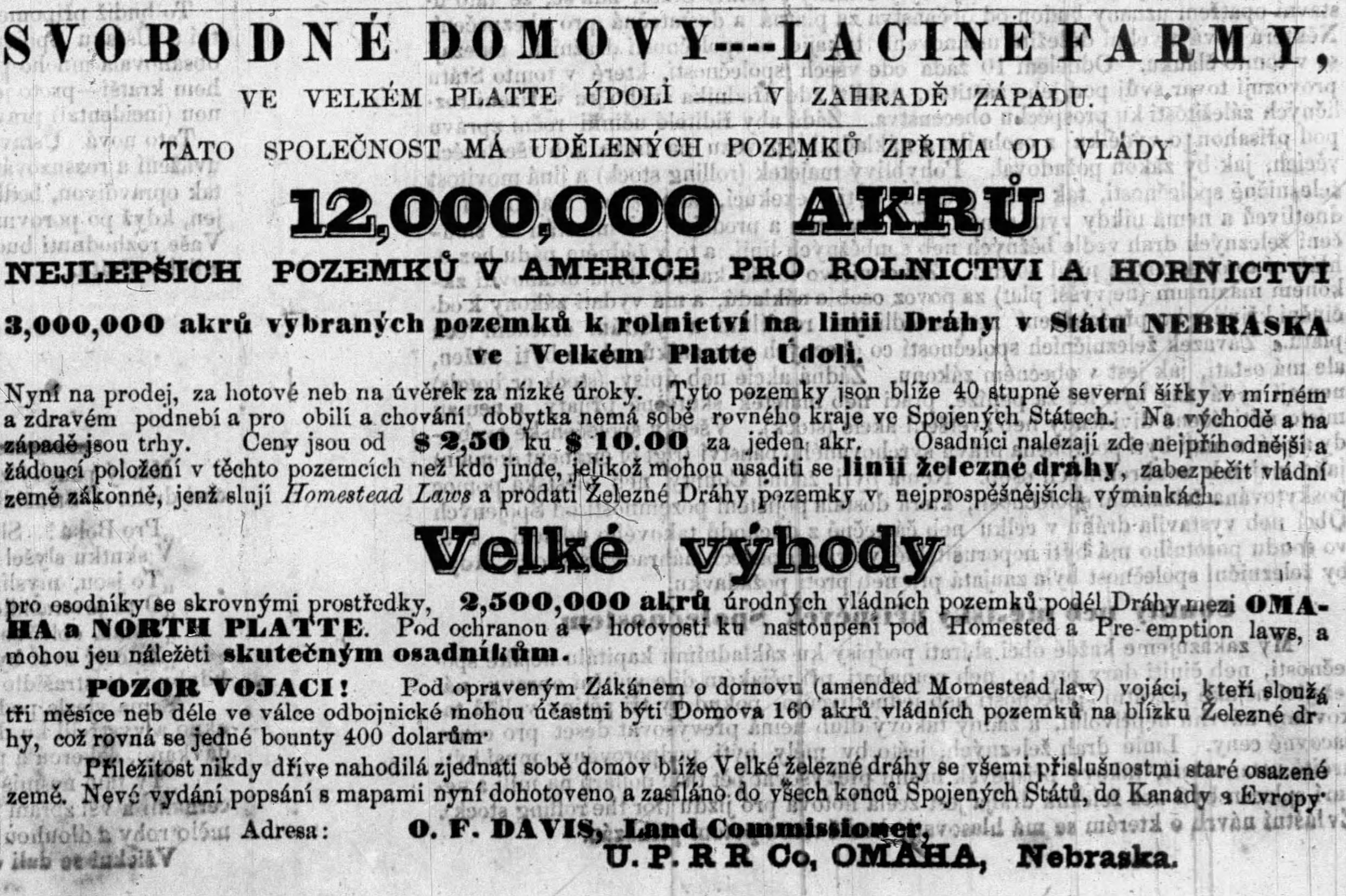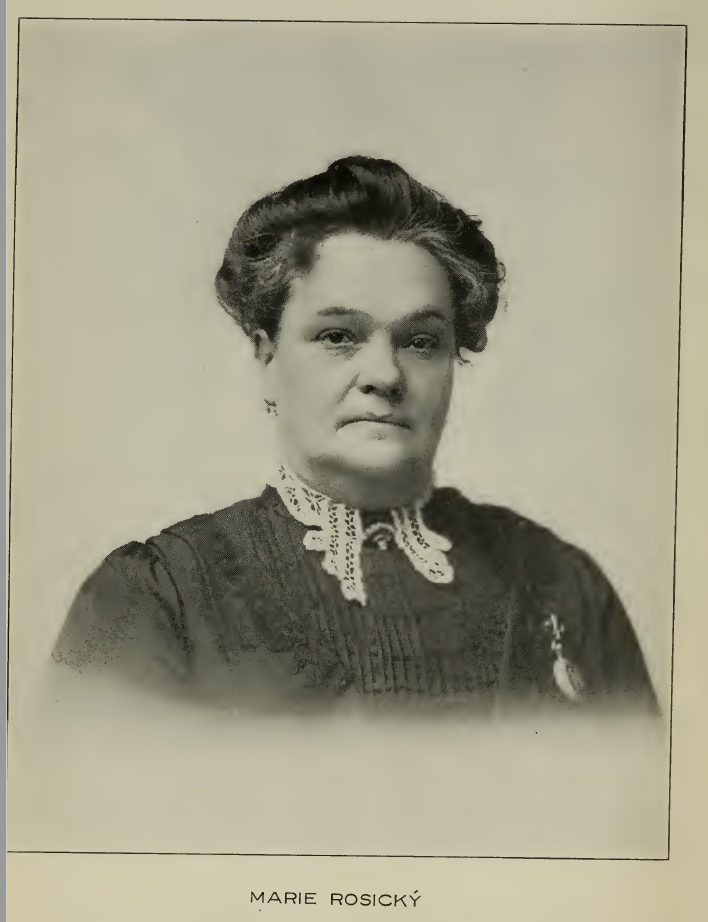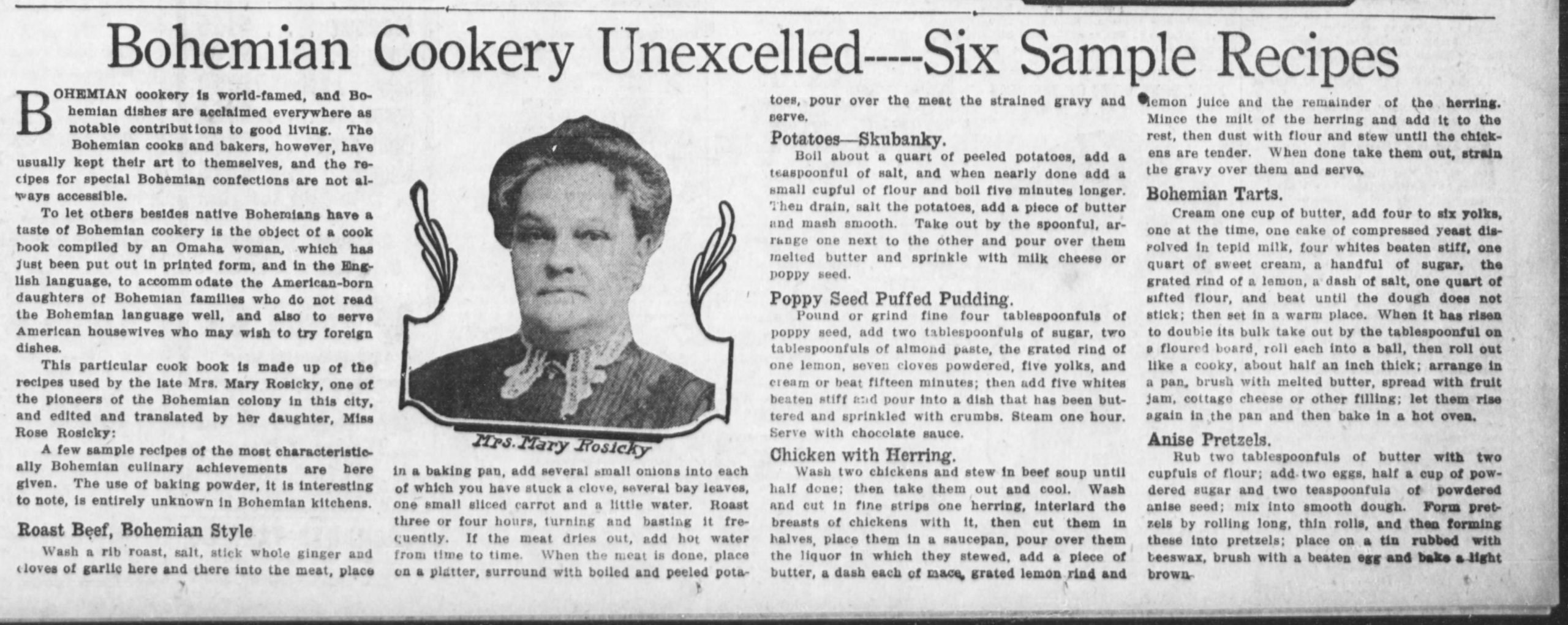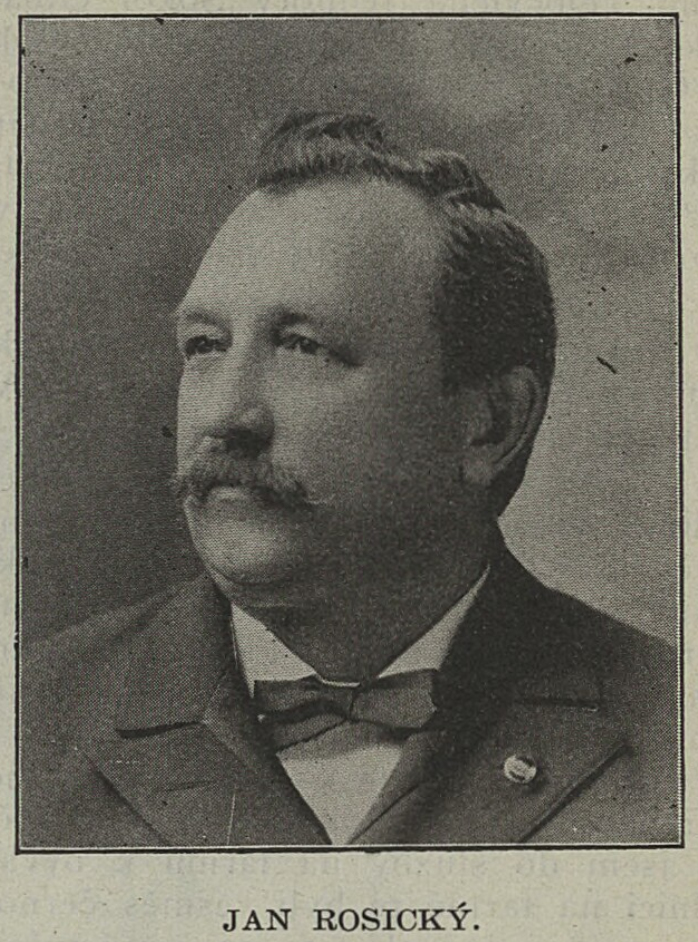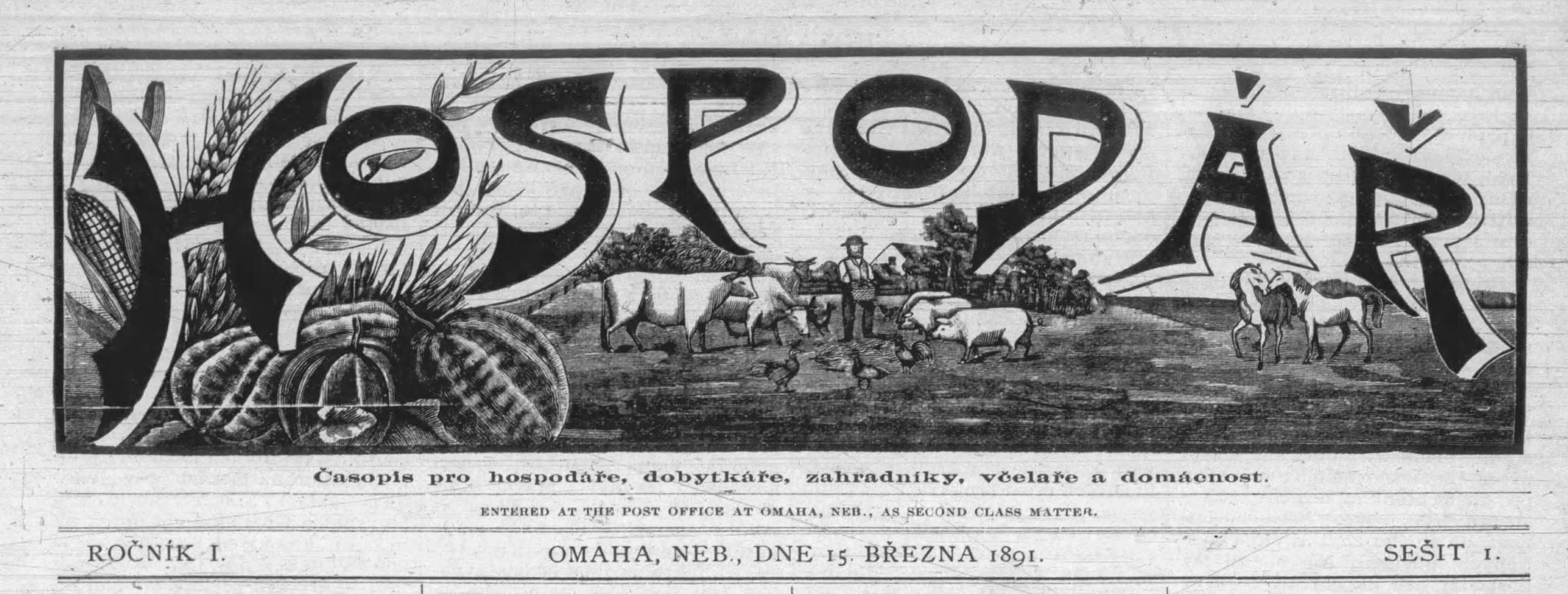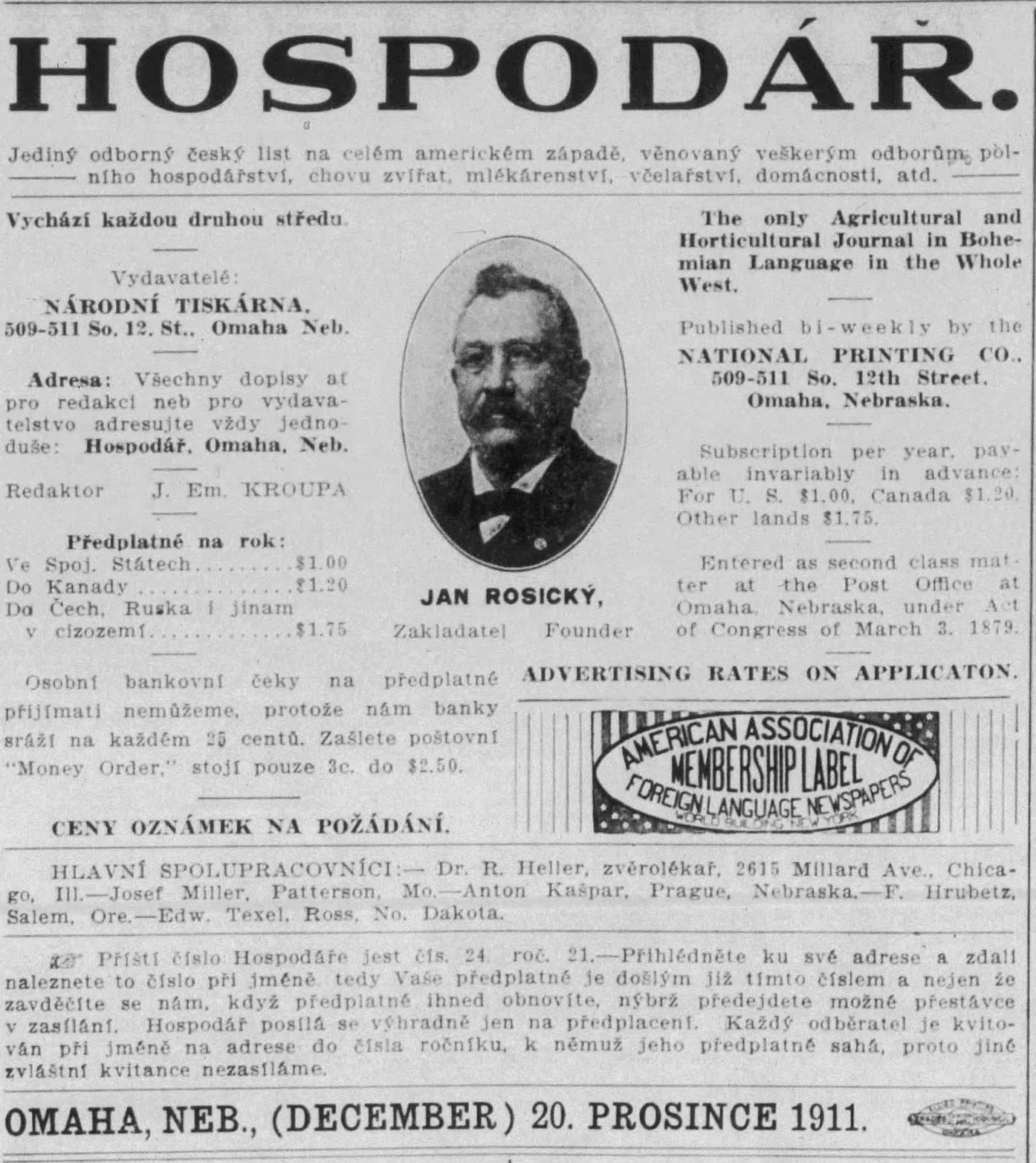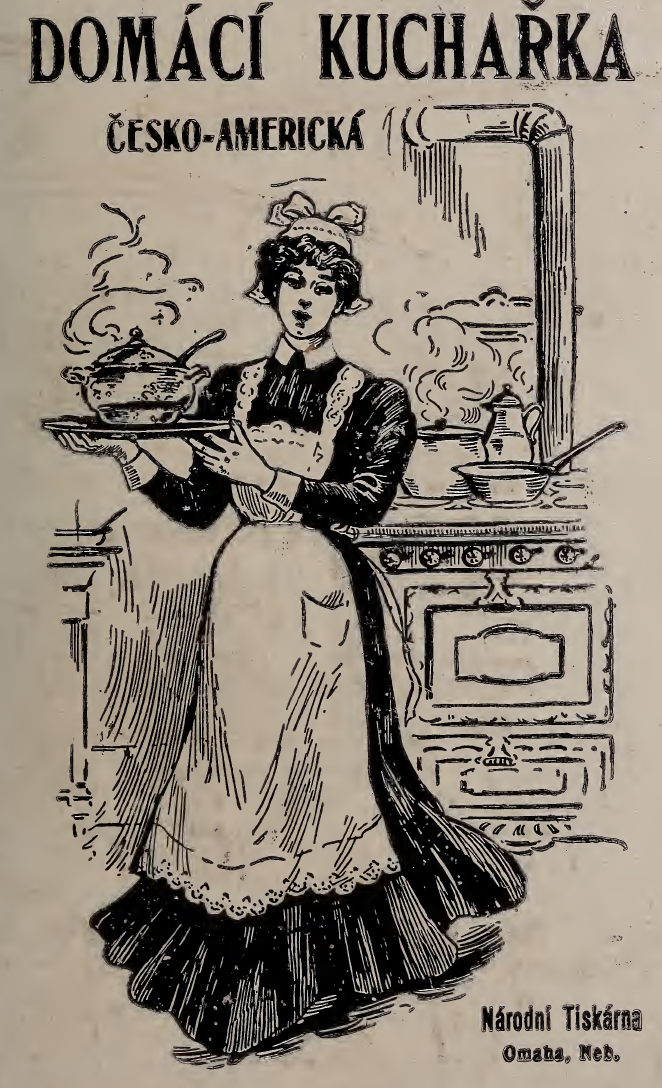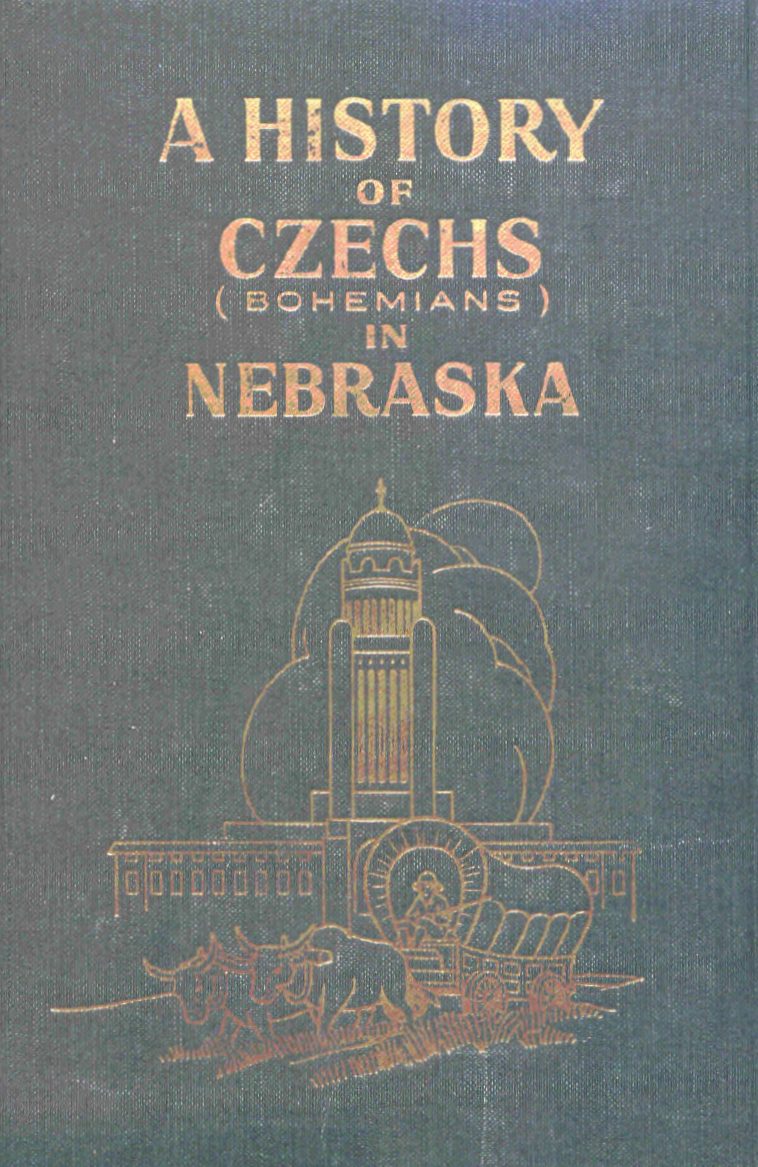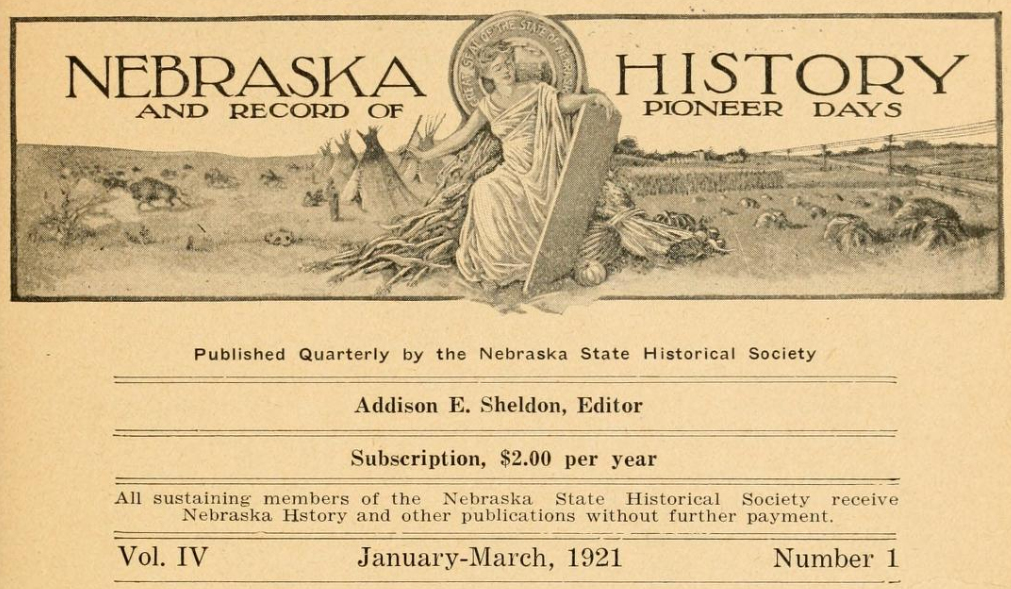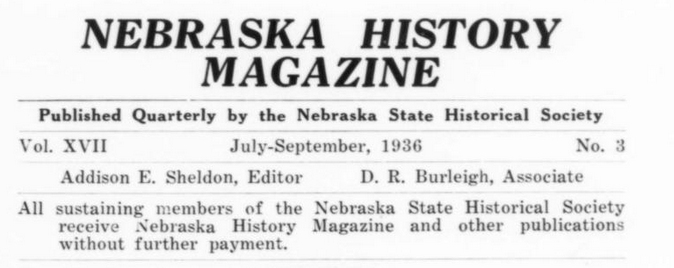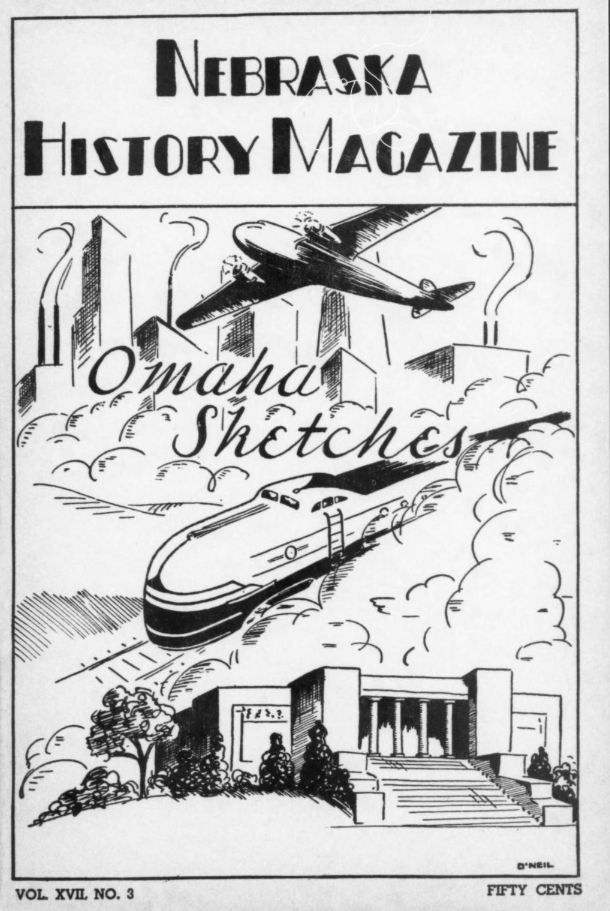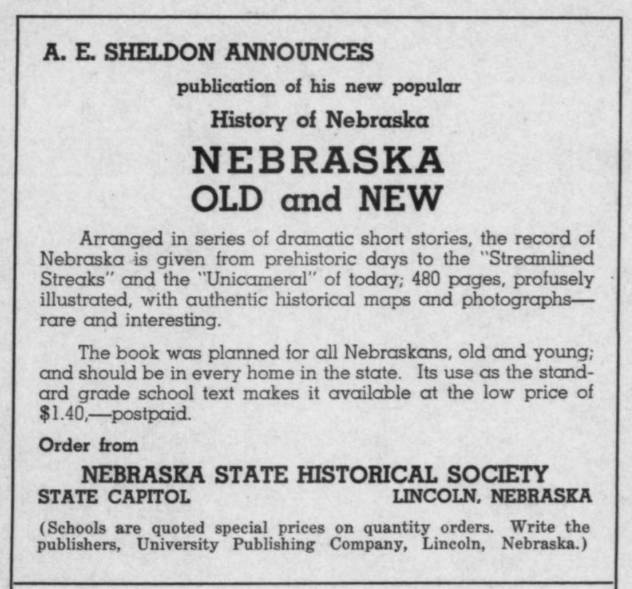Czechs In Nebraska
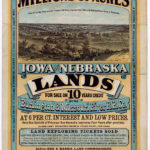 They came to America for what most could not obtain if they stayed home. For many that was land. And for many of those it became land in Nebraska. Czechs began arriving in Nebraska before railroads could transport them there. They came to a land without forests for fuel or building. They came to a land that would not grow the crops they had become familiar with back in Europe. (Image Left - Library of Congress)
They came to America for what most could not obtain if they stayed home. For many that was land. And for many of those it became land in Nebraska. Czechs began arriving in Nebraska before railroads could transport them there. They came to a land without forests for fuel or building. They came to a land that would not grow the crops they had become familiar with back in Europe. (Image Left - Library of Congress)
(Images below - Advertisements for available land in Nebraska from the Pokrok Zapadu 9-15-1871 - Czech foreign language newspaper of Jan Rosicky, Omaha, Nebraska. Access through newspapers.com)
CSAGSI’s Summer 2002 edition of KORENY included an article on Czechs in Nebraska, incorporating information from Czech Nebraskans, Rose Rosicky and Addison Sheldon. That article is reprinted below.
The Book "A History of Czechs (Bohemians) in Nebraska" compiled by Rose Rosicky in 1929 relates how the Czechs lived and battled the frontier in Nebraska.
The reason settlers came to Nebraska is that in 1854 Nebraska settlers could take 160 acres and after living on it six months, buy it from the United States for $1.25 per acre. This was called pre-emption. In 1863, under the new Free Homestead Act, families could settle 160 acres with only a $14 filing fee and have it free by living on it for five years. In 1873 the "Timber Claim Act" was passed, granting a settler 160 acres if he planted 10 acres to trees and took care of them for eight years. All three of these laws were in force from 1873 to 1891, and under them a settler could in a few years get 480 acres of land.
This was important, for it would have taken years for most immigrants to have saved enough to pay S6 an acre for lands which the United States government had ceded to railroads along their rights of way. Other lands in Eastern Nebraska were even higher in price, selling for around $14 an acre.
The earliest settlers literally walked into the state, women as well as men. So far as known, the first Czech to enter Nebraska was Joseph Francl. He came in 1854, but was on his way to the California gold fields. The first permanent Czech settler was Charles Culek (later spelled Zulek), who settled near Humboldt, Richardson County, in 1856, and lived his life there. He knew hardship too, for he used to walk to St. Joseph, Missouri for provisions, and carry them back, a distance of seventy-five miles. He helped his fellow countrymen who, in the earliest years, straggling in by ones, two or threes, turned to him for advice or employment.
The pioneers who came before the railroad was built had only what they brought in their wagons. They came with empty hands, to an uncharted prairie, to an unsettled land. Their first shelter was a dug-out. Dug-outs preceded sod-houses and were built about four feet in the ground by excavating that deep. Sometimes they were built into the side of a hill. For the roof rafters, a few boards or poles were laid flat covered with sod. Fuel was scarce, a problem especially pressing in a state which is lightly timbered. Sunflowers, gun weeds and plum brushes were gathered during the summer, usually by the children, and stored for winter use.
The settlers always brought stoves, for one cannot live without eating. And featherbeds, the prized possessions of Czech housewives meant much, for nothing else gave more warmth and comfort. On more than one occasion a featherbed saved the occupants from freezing to death. A few pieces of furniture, a handful of dishes, a scant supply of clothing this constituted the entire furnishings. Mrs. Mary Jelinek, a pioneer of Saline County, described the interior of their dug-out thus: "In one corner of the dug-out four stakes were driven into the ground, boughs were laid across, then featherbeds and pillows were placed on them, and behold, the bed. Packing boxes served for tables and stumps of trees for chairs." the daily fare consisted mainly of corn bread, corn mush and potatoes. Coffee was made of parched grain. There are exceptions to every rule, and so even then, occasionally a settler lived in better circumstances. To him, came those who had sick ones at home, to ask for a little tea, coffee, salt, sugar or dried fruit, to tempt the patient's appetite.
Oxen were used first because they can subsist without grain. Horses could not be kept until grain had been raised for them. The first year usually five acres of ground were broken and planted to corn, potatoes and pumpkins. There were not enough animals to break more ground and most settlers did not have money to pay for more anyway. An almost complete scarcity of money prevailed in pioneer times, and it has little value anyway. Manual labor exchanged between settlers is much more valuable and important. Besides, there being no towns as yet, nothing can be bought with money even if there were any. Each year more ground was broken and within three- or four-years horses could be kept. Sod-houses followed dug-outs, they in turn were followed by frame buildings, granaries and barns, additional stock and crops acquired, as the conditions of the pioneers gradually improved.
Such were the beginning of early Nebraska Czechs on farms. Latter immigrants who did not engage in farming settled in towns as merchants and artisans, establishing several entirely Czech villages and others almost entirely such. In those years, before machinery or mass production, many industrious and thrifty Czech people acquired modest fortunes. The older children of pioneers had meager schooling, for the schools were few and primitive. However, as soon as opportunity offered, people sent their children to high schools and colleges and today their descendants are found in all the professions. As citizens they have served the state well, also taking part in political life. In 1911 for example, the state legislature numbered ten Czech members.
History relates that the influx of Czechs came between 1865 and 1880, and at the end of this period, fully three-fourths of the immigrants from the Czech lands who settled in Nebraska had arrived. Lives of some early settlers in Nebraska can be found in the book "Nebraska, The Land and the People" by A. E. Sheldon published in 1931. The following paragraphs give some family and genealogical information about several of the Bohemian settlers.
John W. Blezek was born at Baldwin, Iowa, August 20, 1877, son of Mathias and Katherine (Shemerda) Blezek, natives of Bohemia. Mathias came to the United States at the age of fourteen years and settled at Chicago, Illinois, where he remained until he was about twenty-eight years old. while in Chicago he was engaged in building wagons for the old Peter Shutler Wagon company and after he moved to Iowa he continued to make wagons at Baldwin later locating on a farm near Randolph. John W. Blezak attended public schools of Randolph and in 1905 he received a law degree from the State University of Nebraska. On June '5, 1908, Mr. Blezak married Emma Zajicek, of Wilbur, Nebraska. Mr. and Mrs. Blezak have four children.
Frank W. Shonka was born in Bohemia in 1858, a son of Matthias and Mary (Hajney) Shonka. He was about nine years old when he accompanied his parents to the United States in 1867, and lived in Iowa until 1871, when they made their way to Butler County, Nebraska when parents and the first Bohemian priest born and Matthias took up a homestead claim and ordained to Holy Priesthood in Nebraska, was eventually reclaimed and developed a productive born February 4, 1875, at Omaha. He pursued his farm. Frank married Fannie Shimanek of theological studies up to February 1, 1899, when Schuyler and became an executive at the Schuyler State Bank. They had four children.
Frank Dolezal was born March 2, 1867, at Sokoli, Moravia, Bohemia and is a son of Jacob and Josephine (Dohnal) Dolezal. Jacob was born in 1821 at Sokoli, and his wife was born in 1836 at Paclinov, Bohemia and in 1877 they immigrated to the United States arriving in Saunders County, Nebraska, July 16 of that year and took up a homestead in the new country. On April 8, 1891, at Wahoo, Nebraska, Mr. Frank Dolezal was united in marriage with Miss Katherine Zimola. They had five children.
Emil Edwin Placek was born in a sod house in Fillmore County, Nebraska, December 14, 1877, and is a son of Jan and Katherina Placek, both born in 1837 in Bohemia. A farmer by vocation, Jan Placek immigrated to the United States during the 1860's and in 1869 came from St. Louis on a river boat to Nebraska City, whence he drove overland and settled with his family on a homestead at Crete. After improving on his homestead, he disposed of his holdings and moved to Fillmore County where he purchased land from the Chicago, Burlington & Quincy Railroad company. At Wahoo, in 1904, Emil Placek was united in marriage with Elizabeth Lindercamp, a daughter of John and Agnes (Lent) Lindercamp. They had three children.
Rose Rosicky is a native Nebraskan, born in Crete in Saline County July 22, 1875, daughter of John and Mary (Bayer) Rosicky. Both parents were natives of Bohemia. Her father, John Rosicky, settled in Crete in 1873, and in 1876 moved to Omaha, where he was thereafter constantly engaged in the newspaper, book publishing and printing business. He became a leader of his people. Rose, since the death of her father in 1910, has been associate editor of the papers founded by him. these included a weekly and bi-weekly, for a period of time, and the bin weekly farm paper, Hospodar. Her most substantial literary achievement is her history of Bohemians in Nebraska, written in 1926 both in Bohemian and English.
Father Mathias W. Nemec, born of Bohemian he was ordained a priest in the St. Mary's Chapel of the Convent of Mercy in Omaha. He was appointed pastor of St. Wenceslas Parish in 1916.
Otto Kotouc was born in Humboldt, Nebraska April 22, 1885, son of Frank and Marie (Hon) Kotouc, natives of Bohemia. Frank was born October 23, 1839 and his wife was born April 24, 1850. The parents were reared and married in their native land and resided there until 1882. America offered advantages to the foreign born, and they decided to cross the ocean and in the new world give their children the advantages they could not afford in the old country. In his native land Frank Kotouc had been a grocer, but after reaching the United States and settling in Humboldt, he learned the harness making trade in the establishment owned by his brother-in-law John Klossner. On August 29 1912, Otto Kotouc married Camille Cernik, who was born in Ord, Nebraska, a daughter of Joseph and Louise Cernik, also natives of Bohemia. Mr. and Mrs. Kotouc have two children.
Charles Frederick Hynek was born on a farm near the present town site of Wilber, October 14, 1872. His father, who was born in Bohemia, January 1846, was about five years of age when he was brought by his parents to the United States, first settling in Wisconsin. In 1865 he took up his residence in Saline County, Nebraska and embarked in agricultural enterprises. He married Catharina Churila, who was born February 17, 1853, in Stankor Pilsen District, Bohemia and when thirteen years of age came to the United States with her parents. Catharina took an exceedingly active part in Saline County in the Bohemian lodges of J.C.D. and C.B.J. Charles Federick Hynek was united in marriage on November 20, 1894 with Bessie Kaura of Wilber. To Mr. and Mrs. Hynek there have been born four children.
Stanley M. Rosewater, born at Omaha June 24,1885, was the son of Andrew Rosewater (Rozaril), born in Bohemia October 31, 1848. Andrew, who died April 17, 1909 was a civil engineer of national reputation. His family contributed a number of distinguished men to the state. His only son Stanley, was a prominent member of the Omaha Bar Association, active in civic work. Mr. Rosewater married Barbara Hamilton McAlvay of Lansing, Michigan on October 7, 1912. They had two children.
Note: Information on the frontier life of Nebraska pioneers was extracted from the Omaha World-Herald Magazine, March 29, 1953 or the Czech Magazine of November 1939. Additional detailed information on the lives of the early Czech Nebraskan residents mentioned in this can be found in the book by Addison E. Sheldon.
We have found some additional information on several prominent individuals mentioned in the above article, along with resources on various topics related to Czechs in Nebraska.
The Rosicky Family
Jan Rosicky, from Bohemia, living earlier in Wisconsin, and Chicago, married Mary Bayen, born in Bohemia, but from Chicago, in 1874 in Nebraska. (Ancestry - All Nebraska, U.S., Select County Marriage Records, 1855-1908)
Jan Rosicky was a prominent Czech leader in Nebraska. He was also the publisher of early Czech language newspapers, (the Osveta and Pokrok Zapadu, and Hospodar, a Czech Language Agricultural Journal, unique for its time) along with owning and operating his own printing and publishing company (National Printing Company). All three publications, including newspaper clippings below) are available online through newspaper subscription services.
Jan Rosicky worked with many people, including two of the best-known authors of Czech books: Thomas Capek and Dr. Jaroslav Vojan.
When he died, his daughter Rose and sons continued working in their father’s companies.
Jan's wife Mary produced a Czech language cookbook, which became popular, even beyond the Czech community of Nebraska. Its popularity increased when daughter Rose translated the cookbook and published it in 1915.
 Born in Nebraska, daughter Rose Rosicky became a journalist and a prolific writer. Rose contributed articles to her father's Czech language newspapers and wrote articles appearing in English language newspapers as well.
Born in Nebraska, daughter Rose Rosicky became a journalist and a prolific writer. Rose contributed articles to her father's Czech language newspapers and wrote articles appearing in English language newspapers as well.
Rose wrote "A History of Czechs in Nebraska", perhaps the most comprehensive single volume on that topic which included information on Czech settlers by county. Rose translated her mother's Czech language cookbook. Editions of that publication were published decades after the first version.
Rose continued her work in the family business after her parents died, with her two brothers. That included not only the newspapers but also the National Printing Company, also in Omaha, first established by her father.
Listed in the CSAGSI article is Addison E. Sheldon, not a Czech, (born in Minnesota) but such a prolific writer on the History of Nebraska, its settlements, settlers, and timelines of Nebraska history, he provided the historical perspective and background information relating to the establishment and settlement of the state. For decades Addison was involved in the Nebraska State Historical Society and an editor and contributor to their magazine.

Listed in the CSAGSI article are the Rosewaters, Czechs, one ... an engineer, and ..... rosewater, the publisher of one of the very earliest newspapers in Nebraska, the Omaha Bee. (Image Above - newspapers.com)
From Nebraska Author Website: https://nebraskaauthors.org/authors/edward-rosewater
"Edward Rosewater was born in Bohemia, emigrated to the United States, and served the Union as a military telegrapher in the Civil War. That work brought him into personal contact with President Lincoln, and Rosewater was the telegrapher who sent out the Emancipation Proclamation, delivered to the telegrapher's office by Lincoln, in person. His work as a telegraphist brought him to Omaha, where he eventually settled and ran successfully for the State Legislature. He founded the Omaha Daily Bee to support his political and civic projects. Both the paper and its editor were extremely opinionated and pugnacious, Rosewater indulged in street brawls with other Omaha journalists and business owners over controversies that began in the pages of his newspaper. In 1931, Addison Sheldon recalled the paper in its halcyon years, 1871 to 1910, as “the most successful and influential journal in Nebraska.” The paper fell on hard times under the editorship of Edward's son Victor Rosewater, and was eventually sold to the World Herald, which closed it."
From Jewish Virtual Library - https://www.jewishvirtuallibrary.org/rosewater-edward
"ROSEWATER, EDWARD (1841–1906), U.S. journalist, publisher, editor and politician. Rosewater, who was born in Bukoven, Bohemia, went to the U.S. with his family in 1854. He soon became a telegrapher, and as a member of the United States Military Telegraph Corps during the Civil War, he accompanied Union forces and was responsible for transmission of Lincoln's Emancipation Proclamation. Rosewater went to Omaha as manager of Edward Creighton's Pacific Telegraph Company and also worked as a newspaper correspondent. He was elected to the Nebraska State Legislature in 1871 and founded the Omaha Daily Bee in connection with a campaign to establish an Omaha Board of Education. The rights of the common man and public improvements were constantly championed in the pages of the Bee, and though Rosewater gained numerous enemies, he became one of Omaha's best known and most influential citizens. Active in politics, Rose-water served on the Republican National Committee and its advisory board, represented the United States at two Universal Postal Congresses, and served on the Mint Commission. Advocating direct election of U.S. senators, civil service and labor reforms, a postal telegraph system, and postal savings banks, and opposed to trusts and unequal taxation, Rosewater twice unsuccessfully ran for the United States Senate. His son VICTOR ROSEWATER (1871–1940) succeeded him as editor of the Bee. He was active in Republican Party politics, chaired Omaha's first home rule charter convention and served on the University of Nebraska Board of Regents, the Omaha Public Library Board, and other public bodies. He was also a founding member of the American Jewish Committee. Rosewater retired from newspaper work in 1920. He was director of publicity for the Sesquicentennial Exposition, and later devoted himself to writing and lecturing. His books include: Liberty Bell (1926) and History of Cooperative News Gathering in the United States (1930)."
There are some other good Internet Resources for the Rosewaters:
Edward Rosewater - Publisher of the Omaha Bee
https://history.nebraska.gov/collection_section/rosewater-family-rg3628-am/
https://en.wikipedia.org/wiki/Edward_Rosewater
Andrew and Edward
jmaw.org/rosewater-jewish-omaha-bee
Internet Resources:
Nebraska Czechs of South-Central Nebraska
https://www.facebook.com/profile.php?id=100069364174713
Nebraska Czechs of Wilber
https://www.facebook.com/WilberCzechs
Nebraska Czechs of Prague, Nebraska
https://www.facebook.com/nebraskaczechs/
Nebraska Bohemians
https://www.facebook.com/groups/696915460452883/posts/2416541591823586/
Web Sites
University of Nebraska – Czech Heritage Project – If you have an interest in Czechs in Nebraska, you need to visit this site. Many resources here.
https://www.unl.edu/czechheritage/home
– A History of Czechs in Nebraska – 1929 by Rose Rosicky – One of the best books available.
https://www.unl.edu/czechheritage/czechs-nebraska
Bureau of Land Management – Holds records of land purchased directly from the federal government – “Land Grants” and other methods. Searchable database with actual sales documents.
https://glorecords.blm.gov/default.aspx
Nebraska State Genealogical Society
https://www.nsgs.org/index.php
Nebraska Genealogy Trails - Large site:
http://genealogytrails.com/neb/
Nebraska Czechs of Wilber, Nebraska
http://www.nebraskaczechsofwilber.com/
Nebraska Government Site – The Czech American Experience – Another recommended to visit web site.
https://history.nebraska.gov/the-czech-american-experience/
History Nebraska
https://history.nebraska.gov/
Olden Time Nebraska – Lots of stories and many images here
http://www.olden-times.com/oldtimenebraska/index.php
History and Stories of Nebraska by Addison Erwin Sheldon
https://www.olden-times.com/oldtimenebraska/n-csnyder/nbstory/contents.html#contents
Clouds of Grasshoppers in 1874 – Nebraska Land Magazine – referencing Addison Sheldon memories.
http://digital.outdoornebraska.gov/nebraskaland-magazine/clouds-of-grasshoppers-in-1874
Nebraska Studies – The Immigrant Experience
https://nebraskastudies.org/en/1850-1874/who-were-the-settlers-who-was-daniel-freeman/the-immigrant-experience/
Nebraska Czechs of Lincoln, Nebraska
https://www.lincolnczechs.org/
Nebraska Czechs as I Have Known Them – Addison E. Sheldon – Superintendent of Nebraska State Historical Society
http://www.usgennet.org/usa/ne/topic/ethnic/czechs/cz-pg15.html
Nebraska Czechs
http://www.nebraskaczechs.org/
National Park Service – Little Bohemia section of Omaha, Nebraska
https://www.nps.gov/places/little-bohemia.htm
Database of Czech Immigrants – My Czech Roots - This database contains the names of 5600 Czech immigrants living in Nebraska and parts of Kansas as reported in the Hospodar newspaper of the early 1890s.
https://www.myczechroots.com/names-databases/czech-immigrants-in-usa
Thesis Document – Czech Immigrant to Nebraska – Opens a PDF file
https://digitalcommons.unomaha.edu/cgi/viewcontent.cgi?article=1569&context=studentwork
Family Search – Saline County, Nebraska – Genealogy
https://www.familysearch.org/en/wiki/Saline_County,_Nebraska_Genealogy
The Bohemian Café of Omaha, Nebraska
https://bohemiancafe.net/
The Czechoslovak Review – Topic – Bohemians in Nebraska
https://en.wikisource.org/wiki/The_Czechoslovak_Review/Volume_1/Bohemians_in_Nebraska
Graveyards of Omaha – Bohemian National Cemetery
http://graveyardsofomaha.com/index.html
Find A Grave – Bohemian National Cemetery – Omaha, Nebraska
https://www.findagrave.com/cemetery/100413/bohemian-cemetery
The Bohemian Voice – Digitalized copies of several editions – University of Omaha, Nebraska
https://digitalcommons.unomaha.edu/bohemian/
Clarkson, Nebraska - Clarkson Czech Days
clarksonczechdays.org
Nebraska Czechs of York, Nebraska
nebraskaczechsofyork.org
The Rosicky Family of Nebraska
trebohemes.com/2019/05/journalism-in-czech-blood-the-rosickys-of-omaha


